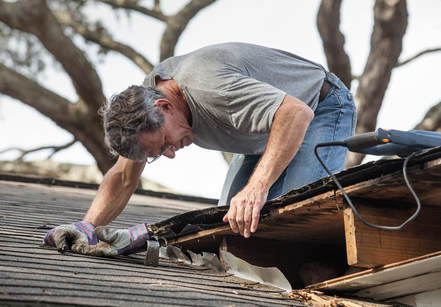Most homeowners know they need their roof replaced when they see a leak in their ceiling or experience a weather event that damages their roof. However, there are many other signs to look for when deciding whether or not to replace your existing roof. Keep in mind that by delaying too long, more extensive damage may have occurred to your roof’s structure and attic, costing more than just a roof replacement.
Roofing contractors agree that regular inspection and repairs, as needed, can prevent the need for more costly repairs in the future.
So how do you know when it’s time?
Roofing material is a major factor in determining if it is time for a new roof.
As a rule:
Cedar: Cedar roofs will split and fall apart in dry climates. They can become mossy in moist climates. Their lifespan is about 20 years.
Tile: Tile roofs can last up to 100 years, but individual times can break and need to be replaced by a specialist.
Concrete: Concrete roofs should never need replacing.
Wooden Shakes: Watch out for damage from termites, carpenter ants, and other wood-boring insects.
Here are some signs to look for with asphalt shingle roofs:
- Roof age
The typical roof will last, according to experts, between 20 and 25 years. Factors such as, whether or not you have several layers of shingles, the age of these layers, and whether or not your roof has been properly ventilated, all determine whether or not a roof replacement is needed.
- The Condition of the Shingles Curling or buckling shingles are aging signs that you may need a new roof.
These can also indicate excessive heat or defective shingles. Curling or buckling shingles may become rigid, break easily, or be damaged by the wind uplift or ice buildup. Roof age or poorly installed underlayment are common causes for curling or buckling shingles.
Check your gutters for shingle granules. Aging shingles tend to lose their granules, indicated by inconsistent or darker color on parts of the roof. In addition, poor water drainage on a second story can cause granules to be washed away over time. Loss of these protective granules can cause the shingle to harden from heat and sun.
- Broken or Missing Shingles
Check your roof for broken or missing shingles. These can weaken a roof’s ability to shed water. High winds and physical trauma to the roof are the most common causes of missing or broken shingles.
- Algae or Moss Growth
Dark streaks can indicate airborne algae. Homeowners often will use a high pressure water hose to remove this algae, causing loss of granules. Moss may grow on roof surfaces where there is less sunlight. This moss can hold moisture against the roof surface causing damage to the shingle granules.
- Roof Valleys
These are important areas of your roof because snow and rain flow through valleys into your gutters. If shingles are damaged or missing in these areas, the chances are high you need a roof replacement.
- Flashings
Flashings are located around skylights, valleys, eaves, rakes, wall details, stacks and chimneys. Water can enter when these flashings lift or separate, causing fasteners to loosen.
- Attics
Check your attic for daylight through the roof boards, signs of water damage or leaking, or dark spots and trails. A spongy feel or bounce when walking on the roof may mean the underlying decking is weakened from moisture.
- Gutters and Downspouts
Examine gutters and downspouts to make sure they are attached securely and are free of debris. The National Roofing Contractors Association (NRCA) recommends a roof inspection at least twice a year, spring and fall. Waiting until water is falling down from a leak can cost you more than just a roof replacement.
Harper Roofing offers a free professional roof inspection at your convenience and will give you an honest assessment of your roof’s condition.

